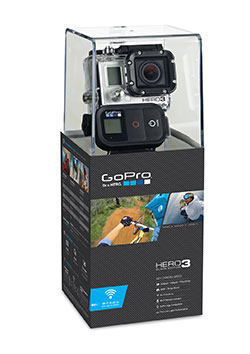GoPro HERO3 Black Edition

 Cigarette Lighter-Sized Camera Has Cinematic Ambitions
Cigarette Lighter-Sized Camera Has Cinematic Ambitions
The HERO3 is GoPro's newest action camera. I tested the most capable version, the Black Edition, with the new optional LCD Touch BacPac and the new minimal-design housing, The Frame. The optional LCD Touch BacPac allows you to frame your shots properly and command the unit.
The HERO3 Black Edition can shoot photos at up to 12 megapixels. It has burst photography, continuous video, combined video and photo capture, and time lapse. The unit also has WiFi built-in (WiFi remote control included). Unlike its predecessor, the HERO3 writes to MicroSD cards. A 16-GB card is good for approximately 45 minutes of 1080p/60fps video, or 2,200 photos shot at the highest resolution setting.
The HERO3 can shoot video at 4K/15fps, 2.7K/30fps, 1440p/48fps, 1080p/60fps, 960p/100fps, 720p/120fps, and WVGA/240fps. The last two modes allow for nice slow-motion effects. There are also new fields of view (FOV) to choose from, including Medium and Narrow at 1080p and Narrow at 720p. These are especially good if you don't want a fisheye effect.
Impressive resolution and frame rates don't always translate to high-quality output, but the HERO3's sharpness, detail, and noise-free image quality surprised me, shot after shot. The low-light noise is a far cry from what the GoPro HD HERO2 generated, and it's better than the performance of many video cameras.
In my opinion, the combination of output quality and FOV options make the GoPro HERO3 suitable for more than just action. This camera is an all-around video and photo camera with the sturdiness required for action shooting.
A lens that allows for focus and aperture settings would make this the perfect B-cam. But even without those, the camera can be effectively used for street videography, photography, and documentaries.
New for the HERO3, and a great addition, is the capability to shoot continuously. This feature, Continuous Photo, takes a series of photos for as long as you hold down the recording button. You can set the camera to take three, five, or 10 photos every second. The Photo Burst default stands at 30 photos per second, although you can set this to a lower number, and the camera takes about eight seconds before it's ready to take the next burst.
The big announcement for the GoPro HD HERO2 was Protune video, which offered a higher bit-rate and allowed for better color grading than the regular GoPro output. In the HERO3, Protune is more professionally implemented, with customizable white balance and even a Camera RAW setting, which saves the video from the sensor. The output from Protune/Camera RAW gives you the ability to color-grade your footage exactly as you want. You can use GoPro's Cineform Studio to give Protune clips a nice look, but you can really get creative by giving the faded-looking RAW file your very own color-and-contrast treatment with DaVinci Resolve, SpeedGrade, Technicolor's Color Assist, or Red Giant's Colorista II.
The optional LCD Touch BacPac ($79.99) that I used for this test is a must-have if you want to properly frame your photo or video clip. The Frame is great when you're mounting the HERO3 on a tripod as you would any regular camera.
Finally, the HERO3 features simultaneous video and photo shooting, and looping video. Looping allows you to capture video for a preset time or until the card is full, after which the previous recording starts to be progressively overwritten.
Company:Â Woodman Labs, Inc. dba GoPro
Price: $399.99
Web: www.gopro.com
Rating:Â 4.5
Hot:Â High resolution; frame rates; picture quality; low-light noise
Not: No lens focus or aperture settings
